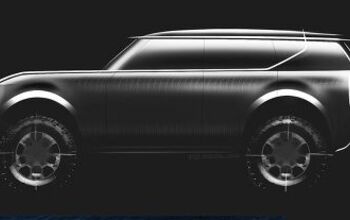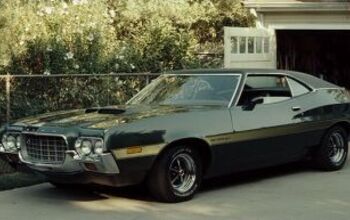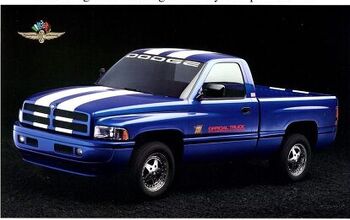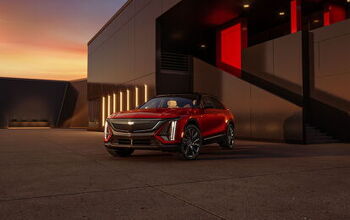QOTD: Are Your Neighbors the Special Ones?

Tim Cain’s observations of his quaint island’s driving habits revealed that electric vehicle ownership, though seemingly feasible given the distance to the sea in all directions, is about as rare as a happy ending on Black Mirror.
Cain, secretly funded by Big Oil and no doubt a part of other shadowy conspiracies, cynically believes that, outside of major urban centers, EVs are generally seen as impractical and unnecessarily expensive conveyances, given their limitations in range and capability. Thus, premonitions of the impending end of gas — or cars in general — are both premature and overblown.
Does your neighborhood’s vehicular landscape reflect this?
Lest anyone thing I was being serious earlier (this is the internet, after all), allow me to say that Tim Cain does not take his marching orders from Exxon-Mobil or BP. That said, I can sympathize with his observations and resulting assertions. While Casa Steph’s surroundings are decidedly more urban (and infinitely less idyllic) than Mr. Cain’s neighborhood, EVs are still considerably rarer than one would assume. Hell, until nine months ago, there was an obscene government incentive available for the purchase of just such a vehicle.
The only electric or PHEV residing in a three-block area is a neighbor’s BMW i3. It stays tucked in the garage, seldom seeing the light of day. A Ford F-150 Raptor loiters a few doors down. I recently saw a pair of Dodge Avengers simultaneously pull into driveways while walking down that same street. It would seem that no one’s trying to keep up with the Johnsons in this hood.
Count me among the many who question the anticipated demand for the electric vehicle tsunami headed our way. While the early product ripples began lapping at our shores early this decade, surging every higher up the beach in the years since, the main event should swamp dealers (and presumably driveways) by 2021-22. Ranges will be substantial — up to and above 300 miles. Bodies will be bold, boxy, and beautiful, far removed from the nerdy, non-Tesla runabouts of yesteryear. Perhaps most importantly, many of these EVs will bear badges worthy of people inhabiting a certain social strata (old money types, wizened bankers, stuffy but image-conscious senior bureaucrats and diplomats, etc).
The type not given to fandom of mass-market Japanese efficiency and Silicon Valley tech bro wunderthings.
Anyway, that’s our supposed future. Looking around your neighborhood, do you see evidence of a growing consumer acceptance of this new way of driving? Perhaps more importantly, do you see any evidence that your friends and neighbors, in the absence of a Euro-style, legislation-driven ICE disincentive campaign, are prepared to give green a chance?
[Image: General Motors]

More by Steph Willems
Latest Car Reviews
Read moreLatest Product Reviews
Read moreRecent Comments
- Lou_BC Are you not entertained?
- Urlik Why it isn’t smaller like the CX-7 was compared to the CX-9. The size is why we passed, they need a tweener again.
- MaintenanceCosts Any plans to build a hybrid with six cylinders?
- V16 The EV9 looks to be channeling a LEGO design.
- Calrson Fan I'm sure it's great vehicle if you never leave town. Trying to tow anything substantial like a small camper into a rural area with it would be a complete disaster, even worse in cold weather. But hey it's so affordable.........wait a minute

































Comments
Join the conversation
The Pittsburgh area is slowly becoming less of an EV wasteland. When I got my former Leaf in 2012, I didn't see another EV until 7 months later. Over the course of that 3 year lease, I didn't actually meet another EV owner for 2 years. Public chargers were very rare. The Ioniq EV I have now is exceptionally rare here because it's a compliance car not sold in PA. I am unaware of any other, except the used one I test drove but didn't buy, and which may not still be in PA. However, I see Model S and 3s almost every day, and the occasional X, and Leafs and Bolts less frequently. There is even a Mitsubishi i-MiEV lurking somewhere in my zip code. A guy at work has a Bolt, but that's the only other EV I'm aware of in an office with 700+ people. There is no charging at work, and I'd be embarrassed to use it anyway. Having just visited Ukraine a few weeks ago, I was stunned at the prevalence of EVs in that poor country. There were a few S and Xs, but a lot of Leafs, which were often used as taxis/Uber in Kiev. These were all pre-2018 Leafs, so they may be castoffs from the US, UK, or Japan for all I know. And, Kiev's charging infrastructure isn't bad. But it's common to see an old Soviet Trabant parked next to an AMG Mercedes, since there is such a big gap between rich and poor there. The car economy there was fascinating - you can get anything you want.
Southern California is EV heaven: abundant infrastructure, mild weather, car culture always up for the new thing. I live in city with a pretty big population of affluent folks. Those who used to buy an S-class now buy a Tesla Model S. Those who used to get a 3-series now buy a Tesla Model 3. Those who used to buy a second-tier luxury brand or a top-trim mainstream brand so as not to look as rich as they are (remember the "noblesse oblige" style of rich people? the ones who would buy Caprice Classic or a 240D in the 80s?) now buy a Chevy Bolt. Loads of hybrids, some plug-in hybrids and EREVs, a smattering of compliance-car second cars (i3, 500e, etc.), and a fair number of fleet Leafs. But for a young family with a modest income in a place where the landlord takes every penny he can, a long-range EV is too pricey, and a short-range EV is too limited. I think it will be a while before the average person even processes that an EV is a possibility for them, let alone seriously shops for one.